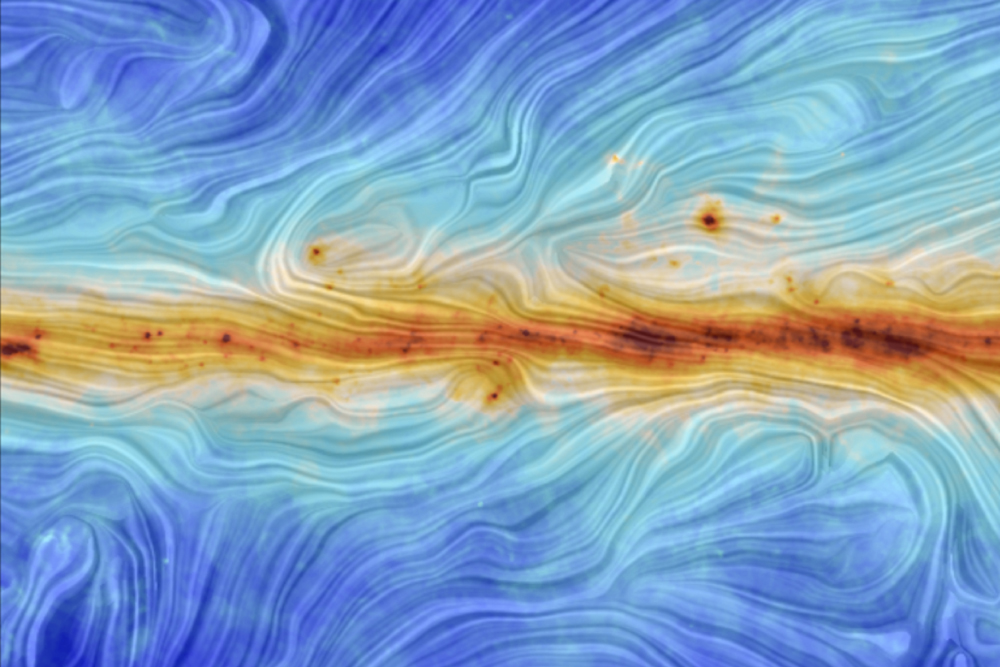The Unification Epicenter of True Lightworkers
The Stars Within Us: Why Everything in You is Stellar

Interstellar dust interacts with the structure of our Galaxy's magnetic field.
Credit: ESA/Planck Collaboration. Acknowledgment: M.-A. Miville-Deschênes, CNRS – Institut d’Astrophysique Spatiale, Université Paris-XI, Orsay, France
Take a deep breath.
That air filling up your lungs, that oxygen pulled into your bloodstream, stoking your metabolic fire, making you possible, is old. Older than you, older than the Earth itself. That oxygen once lived in the heart of a star that is now long dead. That calcium in your bones? That iron in your blood? The same.
Pockets of gas pinch off and catastrophically collapse, in some cases reaching such incredible densities and pressures that nuclear fusion begins deep in the heart of a young system: This is the birth of a star .
The shattered remains of the cloud organize themselves into a disk. The disk spawns planets that cannibalize more material as they grow and compete for space around the new sun. In fits and starts and collisions, and in migrations and bursts of intense radiation, the leftover debris is cleared from the system, leaving a family: a star (maybe two), a few rocky planets, gas giants, asteroids and frozen leftovers in the outskirts.
A solar system is born.
It's elemental
A few new elements breeze into the solar system over the millennia, but by and large, what the solar system was born with is all it has.
The elemental mixture of that primordial gas cloud determines the fate of the system. Not enough silicon? No rocky planets. Just a hint of oxygen? No liquid water on those planets. A bare handful of carbon? Nothing to use to build little critters to swim around in that water.
But how did this solar system's particular mixture of elements get in that gas cloud oh so many billions of years ago in the first place? To tell the truth, I already gave the answer: fusion.
In that newborn sun, and in its heart today, a nuclear fire rages. The crushing weight of the sun's own gravity — layer after endless layer of gas trying to squeeze itself into the center — encourages atomic nuclei to overcome their natural repulsion for each other and fuse, like every bad rom-com you've ever seen.
The fusion process leaves a little bit of energy left over , and the countless fusion reactions are enough to power the sun's radiation for billions of years — and give Earth the warmth and light needed to make life possible.
The process just needs to start with hydrogen, a simple proton. And there is plenty of that in the earliest moments of the universe. All else follows. Every star in the sky, including Earth's own sun, is a massive, sleepless factory for creating new elements. Hydrogen to helium. Onward to carbon, nitrogen and oxygen. In more massive stars, the chain pushes even further, to include calcium, magnesium, neon and argon. All the way to iron and nickel.
Getting heavy
But there, the party stops. After iron and nickel, fusion doesn't produce energy anymore — it takes it. Fusion still happens, but there's nothing to stop the relentless gravitational collapse, no energy production to re-flate the star and balance the contraction. The infalling material tries to jam onto the core, is stopped by the solid iron ball at the center, and quickly retreats. In other words: boom!
A supernova is one of the most fantastic displays of reckless energy seen across the univ... . Billions of stars' worth of energy, wasted in a single flash lasting a few weeks. In that energetic inferno, anything is possible. Want to waste energy fusing some new heavy elements? Who cares — there's plenty to spare! Have some more! It's party time!
It's in that furious explosion that the rest of the periodic table is filled out. What wasn't fused in the heart of a star is birthed in the star's death throes, in complicated dances of nuclei and stray neutrons.
This isn't just a cute bedtime story — this is science, after all, and it requires some evidence. The theory was sweated out in a landmark paper led by physicist William Fowler, who went on to receive a Nobel Prize for his efforts.
And human beings can see how they really are made of stars — the ashes of long-dead stars, but stars nonetheless.
Those points of light in the night sky are connected to people in a deep and meaningful way. Human blood and bones are a part of the natural cycle of formation, birth, life and death of humanity's heavenly cousins. People come from stars and will return to the stars; every star dies, and in some fashion spreads its material back from where it came. And when the light from Earth's sun finally snuffs out, it will carry humanity's ashes back into the darkness, to be reshaped again into new worlds, and possibly new life.
Learn more by listening to the episode "Are We Really Made of Stars?" on the "Ask a Spaceman" podcast, available on iTunes, and on the Web at http://www.askaspaceman.com. Thanks to the City of Lima, Ohio, for the question that led to this piece! Ask your own question on Twitter using #AskASpaceman or by following Paul @PaulMattSutter and facebook.com/PaulMattSutter.
Follow all of the Expert Voices issues and debates — and become part of the discussion — on Facebook, Twitter and Google+. The views expressed are those of the author and do not necessarily reflect the views of the publisher. This version of the article was originally published on Space.com .
- See more at: space.com
Views: 56
Comment
© 2025 Created by Besimi.
Powered by
![]()

You need to be a member of Saviors Of Earth to add comments!
Join Saviors Of Earth